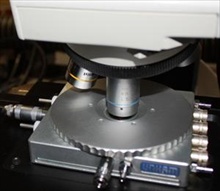Members Login

Channels
Special Offers & Promotions
Linkam temperature controlled probe stage used in conjunction with Raman microscopy at RMIT, Melbourne, Australia
 Market leaders in temperature controlled
microscopy, Linkam Scientific Instruments, report on the work of Dr Sharath
Sriram, a Research Fellow at RMIT University in Melbourne, Australia. He uses
Linkam specialist temperature stages with micro-Raman spectroscopy systems to
investigate temperature dependent spectral measurements.
Market leaders in temperature controlled
microscopy, Linkam Scientific Instruments, report on the work of Dr Sharath
Sriram, a Research Fellow at RMIT University in Melbourne, Australia. He uses
Linkam specialist temperature stages with micro-Raman spectroscopy systems to
investigate temperature dependent spectral measurements. The Functional Materials and Microsystems Research Group comprises a team of researchers adept at thin film synthesis, microfabrication, and materials characterisation developing platforms incorporating electronic materials for research in fundamental physics, applied sciences, and microsystems. ARC Australian Post-Doctoral Research Fellow, Dr. Sharath Sriram, is a key researcher of the Group. He has expertise in the deposition and materials characterisation of complex functional oxide thin films for electronic applications, underpinned by skills in microelectronic fabrication techniques. His current research interests include piezoelectrics, Raman scattering, and electrically tunable behaviour in oxides.
Dr Sriram's interests in characterising piezoelectric thin films led him to choose temperature controlled stages from Linkam for use in combination with a Renishaw inVia Raman microscope. The piezoelectric effect is where an applied pressure generates an electrical charge in certain solid materials. This characteristic is useful for the production and detection of sound, generation of high voltages, generation of electron frequencies, and the ultrafine focusing of optical assemblies. This affect also forms the basis of scanning probe microscopy techniques.
The Groups main area of work has been the investigation of the reversal and pinning of Curie point transformation in thin film piezoelectrics. Using The HFS91-PB4 (HFS600) Linkam stage PSZT thin films were heated to 350°C and cooled at 10°C/min in situ with real-time collection of Raman spectra. This enabled the researchers to determine two main Raman peaks for the film at room temperature, ~575 and ~744cm-¹ (at which point the film had a rhombohedral structure). Controlled heating and cooling of the thin film causes peaks and intensity changes at the Curie point. This is indicative of a phase change occurring at the Curie point, where the film changes from a rhombohedral arrangement to a symmetrical cubic arrangement. This phase change coincides with loss of piezoelectric charge and piezoelectrical structure. With controlled cooling the cubic phase reverses back to the rhombohedral phase with minimum hysteresis, and piezoelectrical potential.
This Curie point transformation from cubic to rhombohedral can be disrupted by uncontrolled cooling, which results in locking in place the peak positions and intensities indicating a permanent phase change and the material remaining "locked" in the cubic phase. This shows fast cooling permanently removes the piezoelectric charge within a material.
Future research will make use of the probe capability of the stage to apply an electrical bias and study Raman spectrum changes in various piezoelectric thin film samples.
Visit Linkam at www.linkam.co.uk and learn about the broad range of applications in the field of temperature controlled microscopy.
Media Partners


